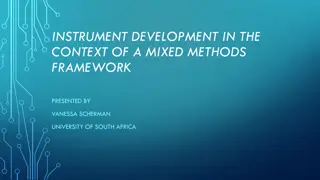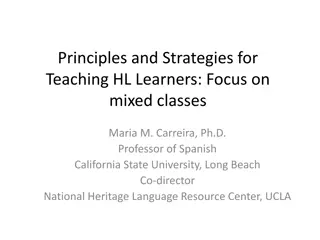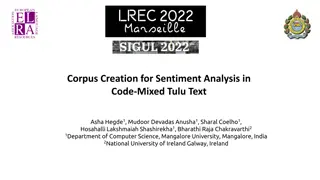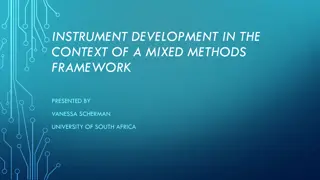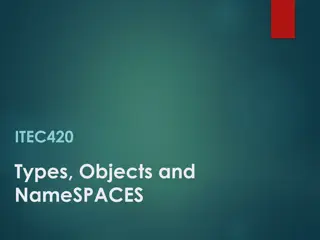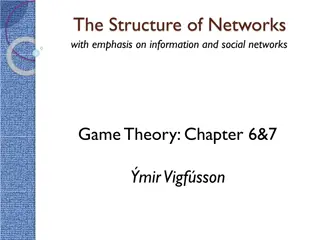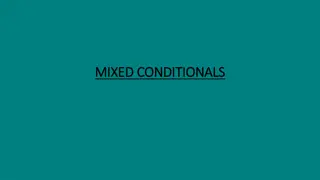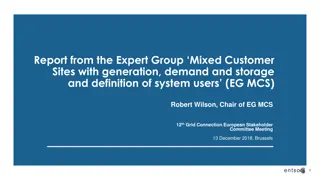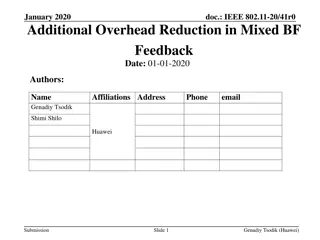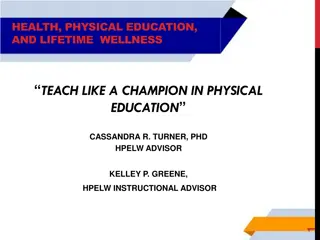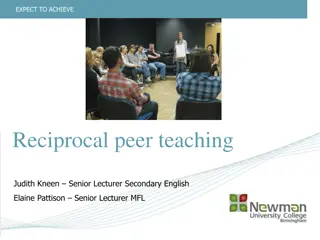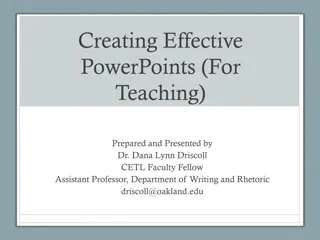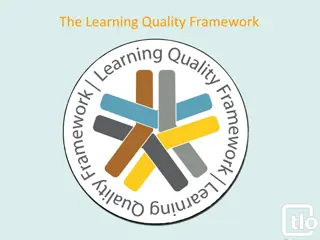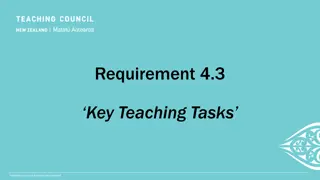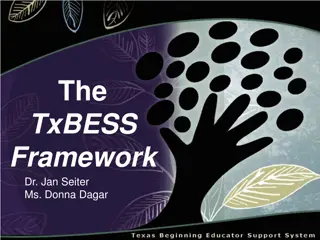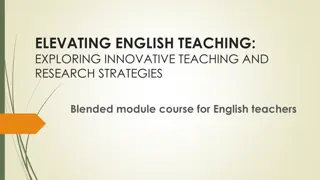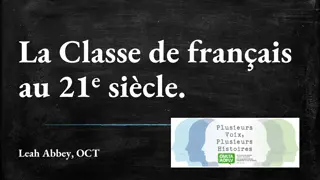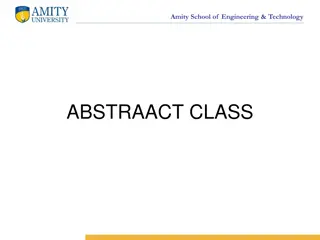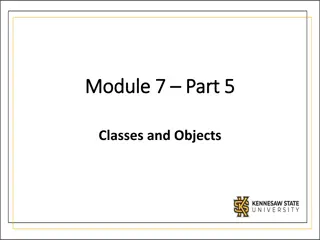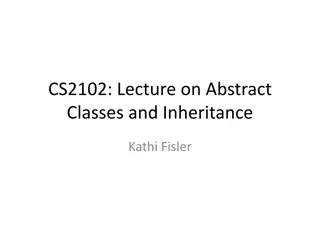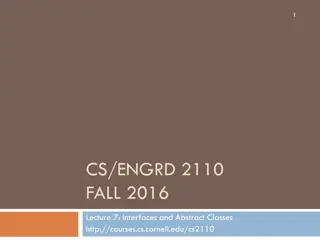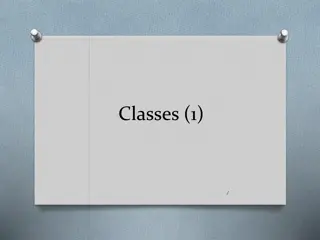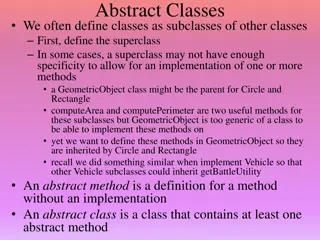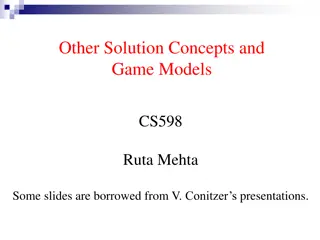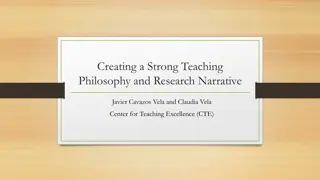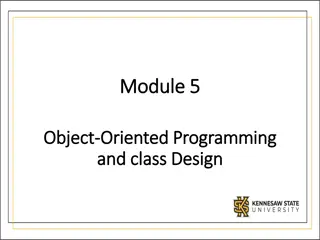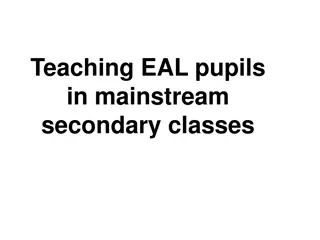Strategies for Teaching Mixed Classes: A Comprehensive Framework
Explore essential strategies and tools for effectively teaching mixed classes, ensuring both student populations benefit from instruction and contribute to the learning process. Discover non-negotiables, positive student interdependence, and insights on research findings, learning from both failures and successes in a mixed-class setting.
Download Presentation

Please find below an Image/Link to download the presentation.
The content on the website is provided AS IS for your information and personal use only. It may not be sold, licensed, or shared on other websites without obtaining consent from the author. Download presentation by click this link. If you encounter any issues during the download, it is possible that the publisher has removed the file from their server.
E N D
Presentation Transcript
A Framework for Teaching Mixed classes
Warm up How many of you teach mixed classes? What are some of the most difficult aspects of this instructional context? What are some advantages?
Making mixed class work: The non-negotiables Both student populations matter: Both learner-types benefit from instruction Both learner-types contribute to the learning process There is positive student interdependence Native speakers?
Positive student interdependence Students: facilitate each others efforts to achieve share resources exert coordinated effort to achieve mutual goals forge caring and supportive relationships (Johnson, D., Johnson, R. and Smith, K. (1991). Cooperative Learning: Increasing College Faculty Instructional Productivity. ASHE-ERIC Higher Education Report No. 4)
Making mixed classes work: Essential strategies and tools Strategies and tools: Areas to attend to: Language What students can do in the target language Flexible grouping Heterogeneous/mixed groups (groups with HLLs and L2Ls) Homogeneous groups (HLL-only or L2L-only groups) Mini-lessons Agendas Anchoring activities Centers Learning Students reactivity to instruction Group membership Affect, aspirations, and culture
Lets start with the non-negotiables Both student populations matter: Both learner-types benefit from instruction Both learner-types contribute to the learning process There is positive student interdependence Native speakers?
RESEARCH ON MIXED CLASSES: LEARNING FROM FAILURES AND SUCCESSES
Instruction is designed such that only one population benefits from instruction (Name of book) does not address the needs of HL but it does a good job at the beginning level where the majority of our students take the (name of language) as general language requirement and where we have less HL (15%) than at more advanced levels (Carreira, 2014).
Lets start with the non-negotiables Both student populations matter: Both learner-types benefit from instruction Both learner-types contribute to the learning process There is positive student interdependence
Students see themselves as being in opposition, not interdependent Both types of students felt ill-at-ease in mixed classes - L2Ls were intimidated by the oral proficiency of the HLLs and the HLLs were intimidated by the grammatical knowledge of the L2Ls (Potowski, 2002).
Students see themselves as being in opposition, not interdependent I felt like I had to hold back in order to get her to participate. She didn't understand some of the words that I wanted to use and I felt bad using words that she wasn't familiar with so I tried to keep it very simple so she wouldn't feel like the story wasn't hers just as much as it was mine (Henshaw, 2015, p. 262). . I hated the fact that I knew more Spanish. It felt uncomfortable because I think I made my partner feel uncomfortable (Henshaw, 2015, p. 262).
Lets start with the non-negotiables Both student populations matter: Both learner-types benefit from instruction Both learner-types contribute to the learning process There is positive student interdependence
Benefits go mostly to one type of learner Also in Henshaw (2015), the linguistic benefits were greater for L2Ls than for HLLs (see also Blake & Zyzik (2003) and Bowles, Adams & Toth (2014). Note: Benefits don t have to be equal all the time. But over the long haul, they should be balanced.
Lets start with the non-negotiables Both student populations matter: Both learner-types benefit from instruction Both learner-types contribute to the learning process There is positive student interdependence
Both student populations matter The large majority of HLLs and L2Ls preferred mixed classes over separate (HLL-only or L2L-only) classes Ribadeneira (2014).
Ribadeneira (2014) (cont.) The advantages was the combination of dialect, formal, informal and [slang] used in all the different forms and allowed for second language learners to see the more informal speaking while helping others to learn the more formal speaking. Being a native speaker I do not focus on grammatical rules. It is good to be exposed to an environment where others can help me focus on these rules. Ribadeneira NHLRC- 2014
Similar comments in other studies Even though I am a native Spanish speaker, I'm not very good with grammar. My partner did help me with some grammatical errors that I had and I appreciated that (Henshaw, 2015, p. 262). Put us together and we're a great Spanish team, aren't we? (L2L to HLL) (Bowles, 2011) See also Pino and Pino (2000).
Positive student interdependence Students: facilitate each others efforts to achieve share resources exert coordinated effort to achieve mutual goals forge caring and supportive relationships (Johnson, D., Johnson, R. and Smith, K. (1991). Cooperative Learning: Increasing College Faculty Instructional Productivity. ASHE-ERIC Higher Education Report No. 4)
Positive learner interdependence L2Ls HLLs
Positive learner interdependence Doesn t just happen when diverse students come together; The instructor must carefully plan out instruction to bring about cooperative learning, sometimes referred to as collaborative or reciprocal learning.
Structuring instructional activities to bring about cooperative learning Activities are designed in such a way that group members need each other to complete them; Members use interpersonal and small group skills that lead to achieving their goals and maintaining effective working relations. (Johnson, D., Johnson, R. and Smith, K. (1991). Cooperative Learning: Increasing College Faculty Instructional Productivity. ASHE-ERIC Higher Education Report No. 4)
What about competition? Can t it push learners to try harder and also be fun? Yes, we will look at this point at the end of this presentation. Reminder: (1) Native speakers, (2) Competition and cooperation
Discussion What types of activities have worked for you from the point of you creating positive student interdependence? What kinds of classroom management issues come up in relation to those activities?
DESIGNING ACTIVITIES FOR POSITIVE STUDENT INTERDEPENDENCE
Some elements of cooperative teams Activities are designed in such a way that group members need each other to complete them; Members use interpersonal and small group skills that lead to achieving their goals and maintaining effective working relations. (Johnson, D., Johnson, R. and Smith, K. (1991). Cooperative Learning: Increasing College Faculty Instructional Productivity. ASHE-ERIC Higher Education Report No. 4)
A COMPARATIVE LOOK AT HLLS AND L2LS
HLLs linguistic strengths and needs are a function of The context of learning: naturalistic setting, primarily the home, informal, home register, perhaps non-standard The timing of learning: early years, diminished or discontinued upon starting school (with individual variation) similar to the language of children, with regard to early - acquired features (e.g. phonology, some vocabulary and linguistic structures, functional skills) The amount input: less than native speakers but more than L2Ls incomplete knowledge of the HL. Missing features are those acquired by children during the school-age years e.g. complex syntax, semantics, and pragmatics, as well as command of different spoken and written registers) The type of input: oral, informal, spontaneous, implicit knowledge of the HL, aural language
L2Ls linguistic strengths and needs The context of learning: school formal, standard, academic, rehearsed, controlled The timing of learning: adolescence, early adulthood adult-like with respect to certain features (e.g. vocabulary, register) The amount input: less than both native speakers and HL learners incomplete with respect to features acquired early in life e.g. phonology, every day registers, etc. The type of input: formal, focused on form, written explicit knowledge of rules and the written language
HLLs and L2Ls tend to have complimentary skills and needs HLLs L2Ls The context of learning: primarily, home informal, home register, non-standard, spontaneous The context of learning: school formal, standard, academic, rehearsed, controlled The timing of learning: early years, diminished or discontinued upon starting school in some ways similar to the language of children The timing of learning: adolescence, early adulthood adult-like with respect to certain features The amount input: less than native speakers but more than L2 learners incomplete with respect to late- acquired items, e.g. relative clauses The amount input: less than native speakers and HLLs incomplete with respect to certain features, e.g. phonology The type of input: oral, informal, spontaneous implicit knowledge of the HL The type of input: formal, focused on form explicit knowledge of rules
Two studies by Melissa Bowles highlight the pedagogical significance of this information
Two studies of paired interactions between HLLs and L2Ls (Bowles 2011) HLLs and L2Ls were matched for proficiency; They worked together on a two-way information gap activity (also called jigsaw); In terms of linguistic benefits, in the first study L2 learners benefited more from the activity than HL learners; In the second study, both types of learners benefited equally from the activity.
First study: L2Ls benefited more from the activity
Second study: Both learners benefited from paired interactions
What made the difference? Material + task Material: HLLs are more familiar with home vocabulary; L2Ls, on the other hand, are more familiar with academic vocabulary; Task: HLLs are better at tasks that tap into intuitive use of language; L2Ls, on the other hand, do better at tasks that require meta- linguistic knowledge (explicit knowledge of rules).
First study: Mostly L2Ls benefited Materials: A picture of a kitchen (home vocabulary) Tasks: Information gap activity involving only oral tasks; HLLs already knew this, so they did not gain much new knowledge. L2Ls benefitted from HLLs expertise. Only L2Ls were in their ZPD.
Second study: Both HLLs and L2Ls benefited Materials: A picture of a school cafeteria (general vocabulary) Tasks: Information gap activity involving oral and written tasks; Vocabulary was unknown to both learner types, so both benefitted.Oral task benefitted L2Ls. Written task benefitted HLLs. Both learners were in their ZPD
Take home lesson from Bowles (2011) about mixed dyads Take advantage of the complimentary strengths and needs of HLLs and L2Ls; When designing activities, include tasks that: 1. are challenging for L2Ls and that HLLs can help with, and 2. are challenging for HLLs and L2Ls can help with.
But this is not enough You have to assign the harder task to each learner; Hold both students accountable for contributing to the activity by using their expertise to help the other learner; And pre-teach the language and skills needed to engage in cooperative learning.
Cloze activity: HL-L2 learner groupings My great-grandmother. I ______liked to have known her, a wild, horse of a woman, so wild she ________ marry. Until my great-grandfather _________ a sack over her head and ________ her off. Just like that, as if she ________a fancy chandelier. That's the way he did it. And the story goes she never forgave him. She _________ out the window her whole life, the way so many women sit their sadness on an elbow. I wonder if she _______the best with what she got or was she sorry because she ________be all the things she wanted to be. Say it Write it
Other common activities Discussing family traditions in small groups Watching a music video What type of learner will be most challenged? Can you think of an add on for the other learner?
Adaptations for mixed groups Linguistic knowledge needed to complete the basic activity and learner comparison Add-ons to create learner interdependence Basic activity Writing a comparison of the different traditions of the group members; Easier for L2Ls/challenging for HLLs Home language; Easier for HLLs/challenging for L2Ls Discussing family traditions in small groups A form-focused activity such as analyzing the verb forms of the piece, transcribing or translating a portion of it, or writing a summary for a TV guide; Easier for L2Ls/challenging for HLLs Intuitive, spontaneous language ; Easier for HLLs/challenging for L2Ls Watching a music video
You can also get a lot of ideas from your students
Recall these quotes from Ribadeneira (2014) The advantages was the combination of dialect, formal, informal and [slang] used in all the different forms and allowed for second language learners to see the more informal speaking while helping others to learn the more formal speaking. Being a native speaker I do not focus on grammatical rules. It is good to be exposed to an environment where others can help me focus on these rules. Ribadeneira NHLRC- 2014
The advantages was the combination of dialect, formal, informal and [slang] used in all the different forms and allowed for second language learners to see the more informal speaking while helping others to learn the more formal speaking. Linguistic knowledge needed to complete the basic activity and learner comparison Add-ons to create learner interdependence. Basic activity Creating an ad campaign for young children (informal language); Easier for HLLs/challenging for L2Ls. Academic language; Easier for L2Ls/challenging for HLLs. Reading an essay on conservation.
Being a native speaker I do not focus on grammatical rules. It is good to be exposed to an environment where others can help me focus on these rules. Linguistic knowledge needed to complete the basic activity and learner comparison Add-ons to create learner interdependence. Basic activity Picking out instances of the grammar point in spontaneous language; i.e. movie, TV show. Easier for HLLs/challenging for L2Ls. Reading a grammar explanation from a textbook and completing a basic practice exercise. Explicit knowledge of the rules; Easier for L2Ls/challenging for HLLs.
But even with all of this Henshaw (2015) reminds us that even when the task includes a writing component, HL learners may not benefit as much from the interaction as L2 learners (p. 266). Hypothesis and solution offered by Henshaw: Hypothesis: HLLs might not trust the L2Ls assistance; Solution: To maximize learning opportunities for both learners the instructor could provide guidance regarding the value of feedback.
This relates to an earlier point You have to assign the harder task to each learner; Hold both students accountable for contributing to the activity by using their expertise to help the other learner; And pre-teach the language and skills needed to engage in cooperative learning.
Recapping Mixed classes succeed when there is positive interdependence between HLLs and L2Ls; To create positive interdependence think in terms of designing activities that take advantage of HLLs and L2Ls complimentary knowledge and skills.


